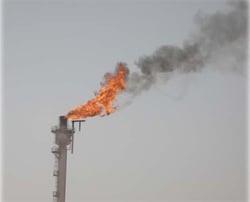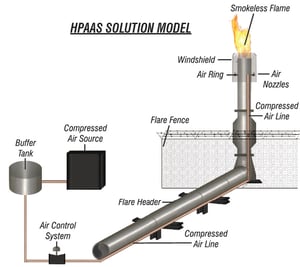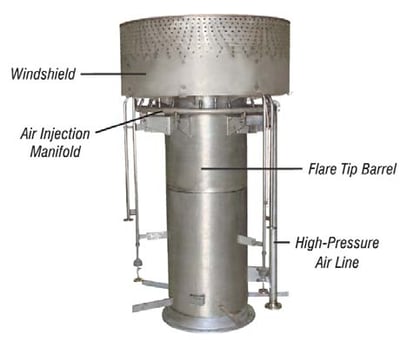高压空气辅助系统
Over the last 10 years Saudi Aramco has developed and patented a smokeless flaring technology that utilizes high-pressure, supersonic air to provide smokeless combustion. This technology, called High Pressure Air Assist System (HPAAS), was developed through an extensive research and development process, utilizing CFD modeling and full-scale combustion testing. HPAAS systems have been installed at dozens of Saudi Aramco facilities, creating clean burning flares where smoke once filled the skies.
Most of these units have been in continuous operation for over one year now, which has provided a method for determining the system effectiveness and reliability. A large range of sizes and operating conditions at these jobsites has provided a good basis for system comparison. Based on information collected from field operators, this paper explores the successes and issues experienced with flare tips, air delivery systems, and severe duty air compressors used in the design, as well as any issues with installation or modification of existing flares. Improvements, limitations, and future changes are also discussed.

Why is HPAAS required?
Approximately 10 years ago, Saudi Aramco personnel became much more aware of the unsightly smoke that was being produced by many of their flare systems on a continual basis. The presence of this constant, visible pollution worsened the public perception of Saudi Aramco and the energy industry in general. They began a search for technology that would help clean up this smoke, and help show Saudi Aramco’s commitment to safe, reliable, and responsible energy production. The solution needed to operate efficiently, eliminate the smoke, and also be cost effective. After a thorough investigation of the smokeless technologies available in the marketplace, they found that none of them worked well for their application.

Components and Operation
The main components of a HPAAS system include a flare tip with supersonic air injection nozzles, an air supply line on the flare stack (normally 2” or 3” diameter), a flow control system, an air receiver tank, and an air-compressor. As an alternative, in some cases the system can also be supplied with air from the existing plant instrument air.

The HPAAS flare tip includes a barrel-type flare tip with a large windshield. In the space between the windshield and the flare tip barrel, a high-pressure air injection manifold is mounted. The air manifold includes supersonic nozzles that are directed upward toward the combustion zone at the flare tip exit. Figure 3 below shows the main components of a HPAAS flare tip.
总结
HPAAS has proven itself as a very useful technology for retrofit applications of existing utility flares. It fills a niche that other technologies were unable to fill in a timely and cost-effective manner. HPAAS will continue to be a useful technology for these types of applications, and with improvements to the technology, it will be used in many more applications.
下载技术文件